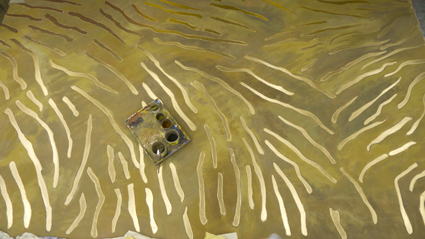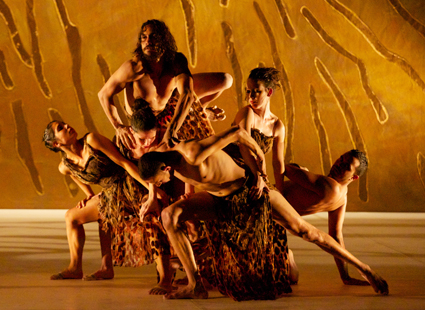design language: place, people, heart
jacob nash: theatre designer

Terrain sets in progress, designer Jacob Nash
photo courtesy the artist
Terrain sets in progress, designer Jacob Nash
THERE IS A VISUAL LANGUAGE CREATED BY INDIGENOUS ARTISTS THAT IS DISTINCTIVE AND IS RECOGNISED BY PEOPLE AS INDIGENOUS. I LIKE THE WORD ‘LANGUAGE,’ BECAUSE IT SPEAKS OF PLACE AND PERSON. THERE HAS BEEN A RICH HISTORY OF INDIGENOUS THEATRE THAT CONNECTS WITH CEREMONY, PAINTING, MUSIC AND DANCE IN THE THOUSANDS OF YEARS PREVIOUSLY AND THIS HAS HELPED TO SHAPE WHAT INDIGENOUS THEATRE IS TODAY.
In a sense, this connection with Indigenous history and culture has inadvertently shaped the images you see on stage, creating a kind of design language. Because of the nature of the stories we tell, there can often be thematically and visually similar elements that appear on stage. Yet there are so few Indigenous designers that you couldn’t really say there is a contemporary design ‘movement’ that is distinct. But at the heart of all design for theatre is creating a visual world that supports the particular story you are telling.
Working with Bangarra Dance Theatre, where there is no script involved, I need experiences that inspire and shape the direction in which the design will take me. For Terrain (2012), choreographer Frances Rings, sound designer David Page and I took a trip to Lake Eyre, where the stories originate. We experienced that country; we met Elders and community and spent time immersed in the place and culture. Creatively, this was a very rich experience. I can’t just sit in a room and create; I have to get out there. I love the word ‘journey’ rather than process because I am on a journey of discovery.
At Lake Eyre I let the country affect me and fill me up. I was very moved by the experience of travelling there. This is where instinct is so important; I have to go with what my heart is telling me and I need to trust that. I had to find a language that would capture the spirit of place, find its heart, its core and create truthful responses to the country and people. Landscape is a hard subject for a designer to work with, as you can’t just depict what you see, but need to find and create images that try to find the essence of place and you do that in colour, light and texture.
As a designer I have to go further than just what is in a script or an idea and find meaning in the subtext. Just because there is a red dirt road in the script doesn’t mean you have to put it on stage. I ask myself what else could this be, how can I keep pushing these design ideas forward? For example in Terrain, in the section called Salt, I had to firstly find out what a salt pan looked like and break down all the elements that made it a salt pan. This gave me a colour palette, a texture, scale and an emotional response. All of the creative ingredients were in front of me—pastel colours, ochre whites, textured clays—and I could express the land in a more abstract form that captures the essence of place. It’s like trying to stir up the memory of the audience to an experience they have had and letting them connect to it in their own way. When all the elements of dance, design and music become one and the dancers begin to tell the story, I feel that I have journeyed some way in capturing that sense of country.
For me, choreographers and directors are usually the first point of inspiration as they pull you into their creative sphere and you get caught in their stories. At Bangarra I get the opportunity to collaborate with inspirational artists (Stephen Page, Frances Rings, David Page, Kathy Marika, Hetti Perkins) in creating, shaping and refining the productions. These relationships are crucial. Working more than once with someone allows me to explore ideas with more trust and it becomes more rewarding. Finding someone who can honestly tell me their opinions about what is working and what is not working in my designs, is essential.

Terrain, Bangarra
photo Greg Barrett
Terrain, Bangarra
Belief is another really important element in the creation; if I don’t believe in what I’ve created, is anyone else going to believe in it? I am sure designers and artists ask themselves that all the time. So for me there is the journey of finding all the inspirational material and having rich experiences, displaying them up on a wall and then responding with pencil, brush, model or whatever. From this point it’s about the critical refinement of the work, and this determines its look. These are some of the hardest but most rewarding moments of the journey.
In terms of the demands or expectations of my work as an ‘Indigenous designer,’ you can only be who you are, and true to what you know and your family. People can place expectations upon you that are sometimes far too great. I can’t fall into the trap of designing stereotypical images of what ‘Indigenous’ is. The biggest demand placed upon me is from myself! When I am entrusted with a story from a community or family, the work I produce has to do justice to the story I have been given. This is because there’s a cultural responsibility to the story you are telling. I have been given a gift and I need to respect that gift.
I am also driven to explore those stories that inform who I am. My birth mum is Aboriginal and we also have Chinese Malaysian blood. My adoptive parents have Irish, English and German heritage. My sister has Papua New Guinean heritage and that’s what I know so far. There are many stories held within this group of people that I don’t know yet and this drives me. I constantly draw upon identity and the past to inform my work.
I think we are about to hit another generational explosion in Indigenous art. If you look back at the past 60 years of Indigenous artistic leadership, there are people who have laid down a strong cultural, political and artistic platform that inspires all of us. It is up to us now to continue in their footsteps.
I want to keep designing. I also want to make a film, paint, travel and work in another country and continue to be inspired by this country, its stories and my family and friends. I don’t know where I will be in another 10 years, but then 10 years ago who knew I would be here?
RealTime issue #111 Oct-Nov 2012 pg. 12






